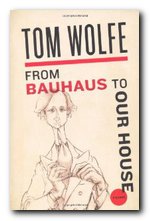cultural correctness and American designers
As a novelist, Tom Wolfe is something of a mixed blessing, but as an essayist and cultural historian he is invariably witty, entertaining, and amazingly well informed. From Bauhaus to Our House is his study which traces the influence of Bauhaus design on American architecture. His argument is that the USA (‘colonials’ as he calls them) was taken in by the revolutionary fervour and the empty slogans of the European cultural Left. It’s an essentially conservative view that claims native American design has been overwhelmed by a form of cultural correctness and a genuflection to False Gods. (His literary style is a bit infectious.)
 What could be a specialist report is made hugely entertaining by his ability as a writer. He pulls out fictional narrative devices and turns of style to take you into the Bauhaus where he gives a satirical account of what it was like to be there – full of tongue-in-cheek mock approval. The weakness of his argument is that he doesn’t take into account the disconnect between the theoretical arguments of artists and the work they produce. Painters, designers, and even architects are well known for making extravagant claims which are not substantiated in their work.
What could be a specialist report is made hugely entertaining by his ability as a writer. He pulls out fictional narrative devices and turns of style to take you into the Bauhaus where he gives a satirical account of what it was like to be there – full of tongue-in-cheek mock approval. The weakness of his argument is that he doesn’t take into account the disconnect between the theoretical arguments of artists and the work they produce. Painters, designers, and even architects are well known for making extravagant claims which are not substantiated in their work.
But Wolfe is well aware of the second part of this conundrum – and he pours ladle upon ladle of withering observation onto contradictions such as Mies van der Rohe’s claims to be designing for ‘workers’ – when he was producing the Barcelona chair which only rich patrons could afford.
Every Sunday, in its design section, The New York Times Magazine ran a picture of the same sort of apartment The walls were always pure white and free of moldings, casings, baseboards, and all the rest. In the living room there were about 17,000 watts’ worth of R-40 spotlights encased in white canisters suspended from the ceiling in what is known as track lighting. There was always a set of bentwood chairs, blessed by Corbusier, which no one ever sat in, because they caught you in the back like a karate chop
It’s certainly true that most of the Bauhaus pioneers emigrated to the USA and found influential positions in universities. Wolfe sees this as a baleful influence which squeezed out native talent. The heroes of his account are mavericks Edward Durrell Stone and Frank Lloyd Wright, and the villains are those who maintained the line of architectural orthodoxy – such as Philip Johnson, Louis Kahn, and Robert Venturi.
In fact he goes on to argue that the dead hand of university-based modernism and academic theory also affected the other arts such as painting, music, and literature. His essay also becomes a critique of the obscurantism of structuralist and deconstructionist theory that plagued cultural debate in the 1980s and 1990s (and still has not been dispersed today).
He’s delighted to recount the disaster stories of public housing designs influenced by Le Corbusier (another villain) – the ‘Projects’ such as the famous Pruitt-Igoe complex in St Louis which was so uninhabitable that the people it was built for voted to blow it up. (A similar fate befell the Manchester slum-clearance ‘Crescents’ in the 1990s.)
He doesn’t come to any particular conclusion, partly because these cultural battles are still raging, but he is very astute in pointing to the origins of faux modernism – chairs which are too uncomfortable to sit in (Gerrit Rietveld) room designs based on theories (Corbusier again) and buildings nobody wants to visit (the Millennium Dome).
This is a very entertaining and thought-provoking text. It’s been around for some time now, but the ideas, the history, and the arguments in it are as fresh as the day it was first published.
© Roy Johnson 2011
Tom Wolfe, From Bauhaus to Our House, New York: Picador, 2009, pp.128, ISBN: 0312429142
More on architecture
More on technology
More on design
